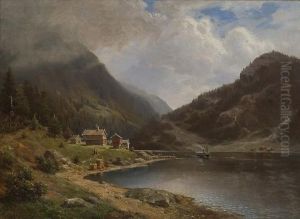Nicolaysen Lyder Wenzel Paintings
Nicolaysen Lyder Wenzel, born in 1832 and passing away in 1916, was a Norwegian architect whose contributions, though not widely recognized on the international stage, played a significant role in the architectural developments of Norway during the late 19th and early 20th centuries. His work, characterized by a blend of historical reverence and a forward-looking approach, reflected the broader movements within European architecture of the time, navigating between historicism and the emerging modernist tendencies.
Wenzel was educated within the context of a Europe that was rapidly industrializing and where the architectural profession was becoming increasingly formalized. He embarked on his career at a time when the demand for architectural expertise was expanding beyond the traditional realms of royal and ecclesiastical commissions to include public and private projects of varying scales and functions. This period was marked by a fascination with historical architectural styles, which were often revived or reinterpreted to serve new functions or to embody nationalistic or romantic ideals.
Throughout his career, Wenzel contributed to the architectural landscape of Norway through a variety of projects, including public buildings, private residences, and ecclesiastical structures. His designs often exhibited a careful consideration of materiality and context, with a particular sensitivity to the Nordic landscape and climate. This attention to the specifics of place and environment is a hallmark of Norwegian architectural traditions, which Wenzel both inherited and helped to evolve.
Wenzel's legacy, while perhaps overshadowed by more prominent figures in the annals of architectural history, remains an important chapter in the story of Norwegian architecture. His buildings, some of which still stand today, serve as a testament to the rich architectural heritage of Norway and the nuanced evolution of architectural thought and practice during a period of significant change. Through his work, Wenzel contributed to the dialogue between tradition and innovation that continues to define architectural discourse.
